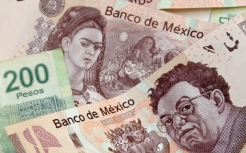Mexican Peso Forex Trading

The History of the MXN
Originally, the term Peso was given to the Spanish 8 Real coins that were issued in Mexico until the first part of the 19th century. In the majority of the 20th century, the Mexican Peso was known to be one of the most stable Latin American currencies, as the economy of Mexico did not go through any periods of hyperinflation like those that had taken place in most of the other countries in the South American region. This changed after the late 1970s oil crisis, when Mexico had to default on its external debt in 1982. This resulted in the country suffering from severe capital flight, and a number of years of devaluation and inflation followed until the Stability and Economic Growth Pact was introduced by the government.
The country’s central bank, the Bank of Mexico, brought out a new currency in 1993 called the Nuevo Peso (or new Peso) as a response to this economic crisis. The word Nuevo was dropped from the currency’s name in 1996, with new bank notes being released into circulation. As the Mexican economy is now stable and the country is enjoying a growth in foreign investment, traders have increased their interest in the MXN, boosting its popularity on the Forex market.
Mexico and its Economic Factors
Mexico’s economy is ranked as 15th in the world in terms of its nominal GDP, and 11th largest in terms of PPP, having remained largely untouched by the 2002 South American crisis. Mexico has enjoyed excellent macroeconomic stability, which has enabled interest rates and inflation to remain low while increasing per capita income; and yet there is still a wide gap between the affluence of the urban population and those who live in the rural parts of the country. There is also disparity between the relative wealth of the northern and southern states, and there are considerable differences between the rich and the poor citizens.
The Mexican government still faces challenges in regard to infrastructure upgrades and labour laws, and tax system modernisations. They are also still working on reducing income equality, as tax revenues are some of the lowest in all of the 34 OECD countries. The Mexican economy has a burgeoning service and industrial sector, and there is an increasing amount of private ownership. Competition is increasing in railroads, ports, electricity generation, airports, telecommunications and natural gas distribution. Over 90% of Mexican trade is carried out under free trading agreements with over 40 countries such as the EU, Israel, Japan and other nations within South and Central America, due to the country’s reliance on exports for the health of its economy. Mexico’s most important trade agreements are with North America and Canada, with 90% of the nation’s exports being sent to these two countries. Mexico also imports 55% of its goods from these two nations.
Catalysts Affecting the Price of the Mexican Peso
Mexico is the world’s ninth biggest producer of oil, meaning that the country is reliant upon its natural resources. The Mexican Peso is therefore tightly correlated to other currencies that are based on its commodities, such as the Colombian Peso and the Brazilian Real. The interdependence between these currencies makes energy fluctuations more important, and traders should be particularly aware of any data that moves the markets for natural gas and crude oil – in particular the US Oil Inventory Report, which is released weekly, and which can have a major impact upon the USD/MXN pairing. Prospective investors in the Mexican Peso should also pay attention to the data releases from the Banco de Mexico, the nation’s central bank, which meets on eight occasions through the year to discuss monetary policy in the country, and to announce updates to the policy through press releases. These meetings are generally scheduled to be held between 24 and 72 hours after decisions have been issued by the US Federal Reserve, and this only serves to highlight how important the interdependence between Mexico and the United States is.







